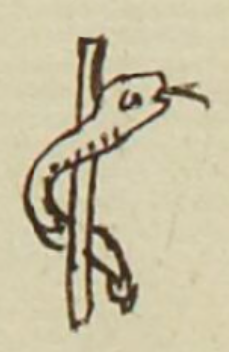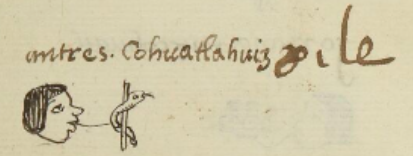Coatlahuiz (MH535r)
This black-line drawing of the compound glyph for the personal name Coatlahuiz (“Serpent-Stick,” attested here as a man’s name) shows a thin, vertical stick with a snake or serpent wrapping around it, ending with its head up and looking toward the reader's right. Its bifurcated tongue protrudes. It has shading on the underbelly, giving it a three-dimensionality.
Stephanie Wood
This serpent-stick may be a reference to the axoquen, which was a digging stick used in agriculture that typically had a zoomorphic head, such as a serpent or a bird.
This image is strikingly reminiscent of the Maturandum published in Europe in 1534 (see Boone, 2020, 22).
Stephanie Wood
1560
Jeff Haskett-Wood
hoes, coas, digging sticks, serpientes, víboras

coa(tl), serpent, snake, https://nahuatl.wired-humanities.org/content/coatl
tlahuiz(tli), see: https://tlachia.iib.unam.mx/glifos/cohuatlahuiz
Serpiente-Palo
Stephanie Wood
Matrícula de Huexotzinco, folio 535r, https://www.loc.gov/resource/gdcwdl.wdl_15282/?sp=149&st=image
This manuscript is hosted by the Library of Congress and the World Digital Library; used here with the Creative Commons, “Attribution-NonCommercial-ShareAlike 3.0 License” (CC-BY-NC-SAq 3.0).




